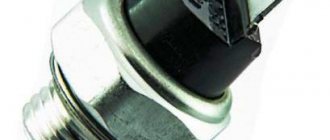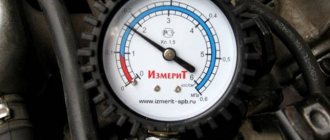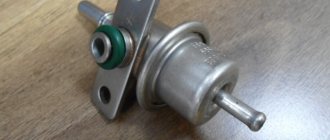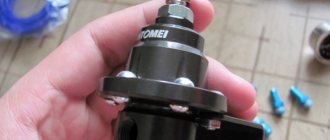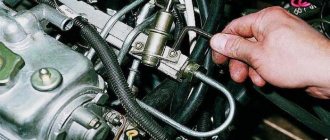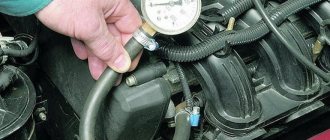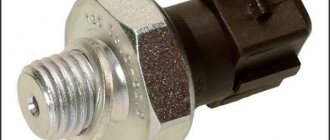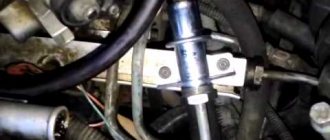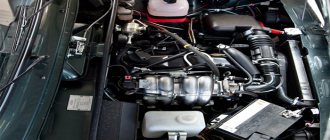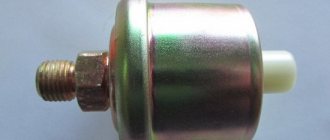On VAZ-2110 vehicles, the fuel pressure regulator ensures the functioning of the fuel injection system in normal mode. With its help, the optimal pressure value necessary for the gasoline to be in a state of fog is maintained in the fuel rail. Due to the pressure, which is higher than atmospheric, the air-fuel mixture is injected into the combustion chambers. If the regulator fails, the entire injection system does not work correctly and serious problems in the functioning of the engine are possible.
How regulators work
The fuel rail is necessary to mix gasoline vapors and clean air. It maintains pressure at 2.9-3.3 kgf/sq. cm due to the pressure regulator. For injection, injectors with a solenoid valve are used. A regulator is connected to them, which is a valve made of a membrane. The device inlet is from the ramp side, the outlet is on the fuel drain line. A tube from the intake manifold is connected to the VAZ-2110 fuel pressure regulator.
The pressure is adjusted using a spring; its rigidity is selected so that it compresses only with a certain force. If the pressure of the fuel mixture in the rail exceeds 3.3 kgf/sq. cm, then the spring compresses, the valve opens and the excess is released into the return line. When the pressure reaches 2.9 kgf/sq. see the valve closes.
Messages 12
1 Topic by Ser_vas_xxx 2014-03-13 18:28:45
- Ser_vas_xxx
- New member
- Inactive
- Registration: 2014-03-07
- Messages: 30 Thanks : 1
- Auto: 21124
Topic: Where is the check valve in the fuel pump
After diagnostics, the control valve in the fuel pump was said to be clogged
The pressure is already 4.5 they told me to clean it, where and how to clean it?! Machine 21124 1.6
2 Reply from chev-viktor 2014-03-13 20:04:39
- chev-victor
- New member
- Inactive
- From: Rostov-on-Don
- Registration: 2014-02-17
- Messages: 96 Thanks : 7
- Car: VAZ2112
Re: Where is the check valve in the fuel pump
The check valve is not cleaned in the fuel pump but in the fuel system
3 Reply from kapelkaK 2014-03-13 21:09:12 (2014-03-13 21:10:03 edited by kapelkaK)
- kapelkaK
- Experienced
- Inactive
- From: Ramenskoye, Moscow.
- Registration: 2013-12-16
- Messages: 313 Thanks : 94
- Car: VAZ 2111, 2001, 1.5; 8V; January 5.1; BK ShtatKh4m.
Re: Where is the check valve in the fuel pump
In what place exactly?
4 Reply from sergo9531 2014-03-13 21:15:38
- sergo9531
- Local
- Inactive
- From: Domodedovo
- Registration: 2014-01-12
- Messages: 578 Thanks : 208
- Auto: 21114
Re: Where is the check valve in the fuel pump
5 Reply from kapelkaK 2014-03-13 21:34:23
- kapelkaK
- Experienced
- Inactive
- From: Ramenskoye, Moscow.
- Registration: 2013-12-16
- Messages: 313 Thanks : 94
- Car: VAZ 2111, 2001, 1.5; 8V; January 5.1; BK ShtatKh4m.
Re: Where is the check valve in the fuel pump
Added: 2014-03-13 22:34:23
6 Reply from sergo9531 2014-03-13 21:36:14
- sergo9531
- Local
- Inactive
- From: Domodedovo
- Registration: 2014-01-12
- Messages: 578 Thanks : 208
- Auto: 21114
Re: Where is the check valve in the fuel pump
kapelkaK , it is the opposite. through it, excess fuel is drained into the tank. This way the pressure is regulated))
7 Reply from kapelkaK 2014-03-13 21:39:10 (2014-03-13 21:39:45 edited by kapelkaK)
- kapelkaK
- Experienced
- Inactive
- From: Ramenskoye, Moscow.
- Registration: 2013-12-16
- Messages: 313 Thanks : 94
- Car: VAZ 2111, 2001, 1.5; 8V; January 5.1; BK ShtatKh4m.
Re: Where is the check valve in the fuel pump
sergo9531 , this is not a check valve, but a return valve (so to speak). The operating principle is different.
8 Reply from sergo9531 2014-03-13 21:52:53 (2014-03-13 21:55:40 edited by sergo9531)
- sergo9531
- Local
- Inactive
- From: Domodedovo
- Registration: 2014-01-12
- Messages: 578 Thanks : 208
- Auto: 21114
Re: Where is the check valve in the fuel pump
kapelkaK , yes, you are right))) let's approach this issue from the other side) Ser_vas_xxx , the pressure in the system is 4.5 atm. pressure is regulated by a pressure regulator (right obvious
) . therefore, it is faulty))) as far as I know, the pump has a check valve (so that gasoline does not escape), but if it were faulty, the car would not start (stuck in the closed position), perhaps the opposite is true - it does not close, but in a running car it not needed
Types of faults
Among the most common device breakdowns are the following:
- The valve does not hold pressure - gasoline circulates freely throughout the entire line, including the return line. In this case, the pressure in the ramp decreases significantly, and it may not be constant. When you increase the engine speed, it begins to stall - there is not enough pressure to carry out normal injection. The amount of gasoline inside the ramp is very small. There is a noticeable decrease in power; it takes longer to start the engine than during normal operation. The electric fuel pump will run longer than usual.
- The valve does not work at all (does not open at maximum pressure) - the excess does not go into the tank. The pressure in the fuel rail is too high, significant excess consumption of gasoline occurs, and the cylinders are flooded. This malfunction of the fuel pressure regulator on the VAZ-2110 cannot be eliminated, so you only need to change the device completely.
Fuel system check valve
Any check valve in any hydraulic system serves to ensure that fluid flows along the line in only one direction. This may be necessary in many cases, but when applied to a fuel system, a check valve prevents unused fuel from draining from the fuel line into the tank. For various reasons, but that's the gist. This applies to both gasoline engines with carburetors, injection engines, and diesel engine power systems.
Video about the operation of a check valve
Structurally, most often the check valve is designed extremely simply - it is a ball valve with a precisely calibrated seat made of soft metal. The valve allows fuel to pass unhindered in one direction, but at the same time fuel cannot flow back into the tank, closing the valve with its own pressure. A simple device, nothing complicated, but sometimes its malfunction or simple absence leads to serious problems. People often confuse a pressure relief valve and a check valve, but these are completely different things. In diesel and injection engines, where pressure is required for the operation of the power system, the pressure reducing valve is responsible for stable pressure, however, it works in tandem with a check valve. It’s logical to solve all problems as they arise, so that’s what we’ll do.
Signs of breakdown
To independently identify a breakdown of the device, take a closer look at the operation of the engine. Typically the fault appears like this:
- The engine's operation is unstable, it shakes, and misfires are felt in the cylinders.
- When idling, the engine stalls.
- Acceleration is weak - throttle response is low, driving is difficult.
- There is a noticeable decrease in engine power; even at minimum load it feels “heavy”.
- The crankshaft rotates either at a low or high frequency. Sometimes the rotation speed varies over a wide range.
- Significant increase in gasoline consumption.
- Jerks and dips during uniform movement.
- Sometimes the breakdown manifests itself as difficulty starting the engine.
- Among the signs of a malfunction of the fuel pressure regulator on the VAZ-2110, one can highlight a significant excess of CH and CO content in the exhaust.
The last breakdown is detected only when diagnosing the engine using a gas analyzer.
Examination
The check must be carried out using a special device for checking fuel pressure (pressure gauge).
This device is connected to the fuel rail fitting and the engine starts. With a working RTD on 1.5 liter engines, the fuel pressure should be from 2.9 to 3.3 kgf/cm²
Then the vacuum tube is removed from the RTD and measurements are taken again. The fuel pressure should increase by 0.2-0.7 kgf/cm².
When the engine is stopped, the pressure should drop slightly and remain in the system for about 2 hours.
Regulator diagnostics
To carry out diagnostics you will need the following tool:
- pressure gauge (the one used to check tire pressure is suitable);
- open-end wrench 24;
- hexagons (only #5 is required).
And now about how to check the fuel pressure regulator on a VAZ-2110:
- Remove the plug from the fitting located at the end of the fuel rail.
- The spool can be unscrewed from the fitting using a cap (metal) for the wheel tires.
- Using a hose of suitable diameter, connect the pressure gauge to this fitting. Be sure to secure the edges with clamps - there is high pressure inside and it can break.
- Start the engine and measure the pressure.
- Disconnect the vacuum tube from the regulator and repeat the measurement.
When the vacuum tube is disconnected, the pressure should increase by 0.2-0.7 kgf/sq. see. If this does not happen, a complete replacement of the device is required.
What to expect from a non-working check valve
Nothing good. At the very least it is a difficult start. Airing of the diesel power system is a rather problematic breakdown on the road. Injection power systems also do not like air in the system. Troubles begin when we turn off the engine, and the fuel, which must wait for the next start (working pressure must be maintained in the system), goes into the tank along the working line, and air takes its place. Now, in order to start the engine, it is necessary to normalize the pressure in the system and supply fuel to the injectors. To do this, you need to turn the engine with the starter for 40-50 seconds, so starting with half a turn is out of the question.
How to replace the regulator?
To replace the regulator, you will need to do the following:
- Stop the engine. Do not perform any actions while the engine is running.
- Relieve pressure in the rail. Simply unscrew the spool valve from the fitting and wait until the pressure equalizes.
- Unscrew the nut that secures the return line pipe to the fuel pressure regulator on the VAZ-2110.
- Unscrew the bolts securing the device body to the fuel rail.
- Remove the regulator fitting from the hole.
- Disconnect the tube from the body.
- Remove the regulator completely.
All steps to install a new device occur in reverse order. Be sure to soak all rubber O-rings in gasoline before installation. All rubber elements that are damaged or have lost their original appearance must be replaced with new ones. Poor quality gaskets and seals will lead to the entire fuel supply system not working properly.
Checking the RTD
So, your sensor is already in order, but there is excessive fuel consumption and other problems indicating that the regulator is acting up. First of all, check it.
- You need to unscrew the plug of the fitting responsible for controlling the fuel pressure. Look, if the seal ring is torn or simply no longer elastic, it (or even the entire plug) needs to be replaced;
- Unscrew the spool from the fitting, this is done in exactly the same way as in any tire;
- Using a tire pressure gauge secured with a clamp to the fitting, measure the pressure while the engine is running. It should be within normal limits;
- When disconnecting the vacuum hose of the regulator, the pressure should increase slightly (by 0.2 - 0.5 kgf/cm2). If this does not happen, then there is only one solution for your VAZ 2110 - you need to replace the RTD. On average, the price of a standard RTD fluctuates around 300 rubles; an analogue of the SOATE RTD costs about 600 rubles.
Device
The regulator includes two cavities - fuel and vacuum. Inside the vacuum there is a membrane that reacts to the air pressure coming from the power unit. Inside the fuel cavity there is fuel under high pressure.
Scheme
The force of fuel pressure is resisted by a valve device. If the pressure is excessively high, the excess is returned back through the relief means.

